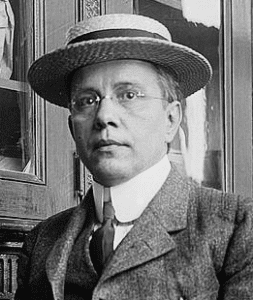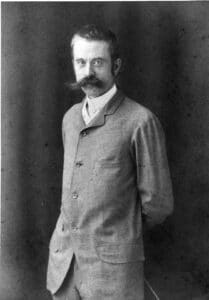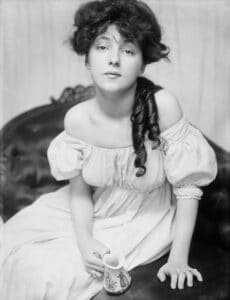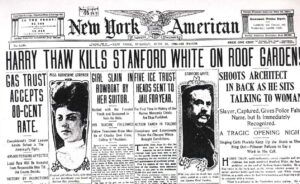“Trial of the century” – it’s a short and snappy phrase that grabs people’s attention. That’s probably why the press has relied on it whenever dealing with a high-profile court case to drum up as much interest as possible for a juicy story that dominates the headlines.
Hey, even we here at Biographics haven’t shied away from using that old adage when describing some of the stories we’ve covered, such as the trial of Roscoe “Fatty” Arbuckle for the murder of Virginia Rappe or the trial of Dr. Sam Sheppard, who stood accused of killing his wife.
But today we’re going back even further, to one of the first-ever cases to earn the moniker of “trial of the century” and, to this day, still one of the most intriguing and shocking – the 1906 murder of renowned American architect Stanford White at the hands of mentally-unstable playboy Harry Thaw, ostensibly to protect the honor of his wife, famed supermodel Evelyn Nesbit.
So what made this case so compelling? One contemporary reporter listed all the qualities of this murder scandal that gripped the nation:
“You see, it had in it wealth, degeneracy, rich old wasters, delectable young chorus girls and adolescent artists’ models; the behind-the-scenes of Theatredom and the Underworld, and the Great White Way. . . the abnormal pastimes and weird orgies of overly aesthetic artists and jaded debauchees…”
This is the story of a love triangle that ended in murder and became front-page news all over the country as America waited to find out with bated breath what fate would befall Harry Thaw, the killer playboy.

The Early Years
Harry Kendall Thaw was born on February 12, 1871, in Allegheny City, Pennsylvania, today a part of Pittsburgh, to William Thaw Sr. and his second wife, Mary Sibbet Copley.
To say that Harry was born with a diamond-studded silver spoon in his mouth would still be an understatement. His father was a railroad magnate, estimated to be among the 100 richest people in America. Unsurprisingly, young Harry lacked for nothing in his life, even though from childhood he exhibited paranoid behavior and was prone to outbursts of violence. At no point did anyone try to do anything to correct his conduct, punish his actions, or even try to get him professional help, since it was probable that he struggled with some mental illness. Instead, if Harry got into trouble at school and got expelled, his father would move him to another fancy private school. From a young age, Harry was taught that his money and his social status placed him above the rules of society, which were used to govern mere mortals.
Acting the way he did, Harry never did well in school, but this mattered little. When it was time for college, his father made sure that he got accepted at the University of Pittsburgh to study law. There was little studying to be had, though, and soon enough Harry would have even less incentive to do so. In 1889, William Thaw died, leaving behind a giant trust for Harry and a generous yearly allowance. And by “generous,” we mean more money than most people made in their entire lifetimes.
Harry Thaw was now a very rich man and free to indulge in his every whim. And not that his father was ever a drill sergeant when it came to raising him, but his mother was even more nonchalant about his behavior. As Mary Copley’s first child, Harry was the apple of her eye, and throughout the rest of her life, she would always be more concerned with protecting her son from the consequences of his actions than trying to get him to mend his ways.
Up until this point, Harry wanted to attend the University of Pittsburgh because it meant he could go home to his palatial estate instead of living in a cramped dormitory. Now, however, finding suitable living arrangements was no longer a concern, so he used his newfound wealth to transfer to Harvard.
This was all about bragging rights. Only so Thaw could say he attended the prestigious Harvard University. Just like before, he had no interest in any of the scholarly pursuits that the college had to offer. Once, when asked what he studied at Harvard, Thaw jokingly replied “Poker,” which had been complemented by bouts of all-night drinking binges, attending cockfights, and a string of quick romances.
Money might have gotten Thaw through the door of Harvard, but it didn’t keep him there. It seems he went a step too far one night when he chased after a cab driver armed with a shotgun. His defense was that the weapon was unloaded, but the university president probably had to deal with one spoiled brat too many that day because he still expelled Thaw.
Poor Harry was out on the streets, but then he remembered that he was still a millionaire who could do pretty much anything he wanted and cheered up a bit. After he was done with his quote-unquote education, he split his time between Allegheny and New York City, with frequent trips to Europe where he could let loose a little and unwind after all those stressful months of doing nothing back at home. He was already starting to develop a reputation. His parties and his antics were becoming well-known, both in New York and in Europe. There was even a popular new word used to describe the lifestyle of someone like Harry Thaw – that of a “playboy.”
Evelyn and Stanny

Harry Thaw might be the guy whose name is in the title of this video, but he only makes up one-third of our little lethal love triangle. Let’s meet the other two bedfellows.
First up is Evelyn Nesbit, a woman once dubbed “the most beautiful artists’ model in the world” and regarded by some as the world’s first true supermodel. With that kind of claim to fame, it’s no surprise, really, that men were willing to kill for her.
But we’re getting ahead of ourselves. Florence Evelyn Nesbit was born on Christmas Day, 1884, in a small community just outside Pittsburgh, Pennsylvania. The family moved to the city a few years later, where Evelyn’s father, Winfield Scott Nesbit, worked as a lawyer who was struggling to make ends meet. Things got significantly worse when Winfield Scott passed away, leaving his family in debt and without a source of income.
It was a desperate time for the Nesbits, but fortunately for them, Evelyn grew into a stunning beauty from a young age. She was first asked to pose for a portrait by an artist from Philadelphia when she was only 13 years old. Afterward, she also posed for a photographer, and her pictures made it into an art magazine that garnered a lot of attention. It wasn’t long before she was one of the most in-demand models in Philadelphia, and the money she was earning was enough to support her family.
Unsurprisingly, Evelyn’s mother realized that this could be not only a viable but a highly lucrative career for her daughter. So in 1900, the two of them packed up their bags and moved to New York City in the hopes that they would strike it big. And indeed they did. Word of Evelyn’s transcendent beauty had already reached the city, and it wasn’t long at all until the 15-year-old model was sought after by some of the biggest artists in the country.
James Caroll Beckwith was the first painter in New York to take the young Evelyn under his wing, and he introduced her to many prominent names in the art world. She posed as a Gibson Girl for Charles Dana Gibson’s drawing Women: The Eternal Question and for George Gray Bernand’s sculpture Maidenhood (Innocence), not to mention countless magazines such as Harper’s Bazaar and Vanity Fair. But it was in Gibson’s studio that Evelyn met the third and final piece of our puzzle, a man by the name of Stanford White.
Thirty years her senior, Stanford White was already one of the biggest hotshots in the architectural world by the time he met Evelyn Nesbit. He had made his name (and his fortune) by mainly designing lavish mansions for the rich & famous, but he also had several notable landmarks to his credit, such as the Washington Square Arch in Manhattan, Tiffany’s jewelry store, and the second incarnation of Madison Square Garden.
White was also the kind of man who got what he wanted, and once he set eyes on Evelyn, he decided he wanted her. By that point, the young model was looking to expand her horizons and had joined the world of theater, getting a part in one of the most popular Broadway shows of the early 20th century, a musical comedy titled Florodora. The play featured a line of beautiful chorus girls, of which Evelyn was now part, collectively known as “Florodora girls.”
This also meant that Stanford White could see Evelyn whenever he wanted. At first, he played the role of benevolent benefactor. He started with some compliments, then he bought Evelyn a few gifts, and before you knew it, he was putting her up in a luxurious apartment and giving her an allowance. Of course, all of this was simply the prelude to what White was really after. One night, Evelyn’s mother was away in Pittsburgh visiting relatives, and it was just the two of them, and White made his move. What exactly happened that night depends on whose account you believe, but at best, the architect got a 16-year-old girl drunk and took advantage of her. At worse, he drugged and raped her.
Evelyn, despite her beauty and success from an early age, was still a naive and inexperienced young girl. The influence and control that White exerted over her was too strong, so even after what happened that night, the two began an affair.
Their relationship, if we can call it that, lasted about a year before the architect grew bored of the chorus girl. This was standard practice for Stanford White. Evelyn Nesbit was not the first girl to receive the treatment, nor was she the last. His reputation as a predator who targeted young women was well-known in New York’s high society, as evidenced by none other than Mark Twain, who briefly wrote about the murder trial in his autobiography. Here is what the novelist had to say about Stanford White:
“…The witness charges the middle-aged architect…with eagerly and diligently and ravenously and remorselessly hunting young girls to their destruction. These facts have been well-known in New York for many years, but they have never been openly proclaimed until now. On the witness stand, in the hearing of a courtroom crowded with men, the girl told in the minutest detail the history of White’s pursuit of her, even down to the particulars of his atrocious victory – a victory whose particulars might well be said to be unprintable…
New York has known for years that the highly educated and elaborately accomplished Stanford White was a shameless and pitiless wild beast disguised as a human being; and few, if any, have doubted that he ought to have been butchered long ago, by some kindly friend of the human race.”
Evelyn and Harry

During one of Stanford White’s famous parties, Evelyn made the acquaintance of 21-year-old John Barrymore, part of the illustrious Barrymore acting family, and the two quickly became smitten with each other. Although John Barrymore would go on to achieve great fame in his career, this version of him was a young, struggling artist who mainly did illustrations for newspapers. Evelyn’s mother did not approve of their budding romance, so when Barrymore proposed marriage, she sent her daughter away to a boarding school in New Jersey.
When she was still performing on Broadway, Evelyn followed up her successful stint in Florodora with a part in The Wild Rose, where she had a more prominent role instead of simply as a chorus girl. Once again, she dazzled her adoring public, and among the audience left smitten by her beauty was none other than Harry Thaw.
At first, Thaw tried to win Evelyn over under the guise of a “Mr. Munroe” and sent her lots of expensive flowers after each performance of The Wild Rose, often accompanied by a $20 or even $50 bill…because that’s the kind of romantic guy he was. But this alone was hardly enough to make Evelyn swoon. After all, she had plenty of rich men vying for her affection. She was not impressed and had most of the gifts sent back. Eventually, Thaw tried scheduling a lunch date with the actress through a common acquaintance and, as it happened, he picked the perfect time. Evelyn was feeling down about having to return to the boarding school in New Jersey and thought that finally meeting the mysterious Mr. Munroe would make for an intriguing distraction.
When the two were face to face, the playboy dropped the fake name and announced himself proudly as “Harry Thaw of Pittsburgh,” his favorite way of introducing himself, but this left the actress more bemused than impressed. The luncheon didn’t go particularly well, and Evelyn felt relief when Thaw departed, but he was not the kind of man to give up so easily. He continued his dogged pursuit of her, partly out of passion, but also out of a desire to harm and humiliate Stanford White.
Although when and how exactly this enmity started we cannot say, we can tell you that Harry Thaw loathed the architect before he ever heard of Evelyn Nesbit. This all may have begun with a single bad interaction at a party but, in Thaw’s paranoid mind, he soon became convinced that Stanford White made it his mission to turn him into a social pariah and used his connections to deny Thaw entry into the most prestigious clubs in New York such as the Metropolitan, the Knickerbocker, and the Players Club.
Anyway, the playboy millionaire kept trying to woo Evelyn, although he had more success winning over the girl’s mother than Evelyn herself. But then an opportunity presented itself for Thaw to show his dedication towards the young actress. Evelyn fell ill with appendicitis. While she was recuperating, she stayed in a sanatorium in New York City and, as you would expect, both White and Thaw visited her often to lavish her with gifts and attention. However, by the time she returned home, White was starting to get bored with her and was ready to move on to the next showgirl. Harry pounced on the moment and convinced Evelyn’s mother to let him take her daughter on an extended trip to Europe in May 1903 to aid in her recovery.
At first, he was the perfect gentleman, even as Evelyn continuously rebuffed his offers of marriage. Then things changed when he finally got her to recount how Stanford White took advantage of her. Outwardly, he was caring and consoling towards Evelyn. He said all the right things, but there was a definite change in his demeanor. He became colder and started making snide remarks, not only toward White but also toward Evelyn. While visiting Domrémy, the birthplace of Joan of Arc, Thaw wrote in the guestbook that “she would not have been a virgin if Stanford White had been around.”
While in Austria-Hungary, Thaw rented Katzenstein Castle, where the couple stayed for a few weeks. In that remote edifice where the two were isolated and alone except for a few servants who stayed at the opposite end of the castle, Evelyn saw for the first time the true Harry Thaw. One night, he burst into her room naked. He began tearing at her nightgown and whipping her violently with a riding crop. The harder she fought back, the harder he hit her until her body was full of long, bloody lacerations. And then he proceeded to assault her the same way as White.
The attack stopped as suddenly as it began. Afterward, Thaw got up calmly, left the room, and locked the door behind him. The next day, he acted as if nothing had happened, and the European tour continued. It wasn’t until late October that Evelyn arrived back in New York City, but Thaw continued his pursuit of her undeterred, and, shockingly, it worked.
Perhaps Evelyn felt trapped between two violent, domineering men and thought that she had no choice but to choose one of them. Perhaps she thought that, as word spread around town that she was Stanford White’s mistress, her chances of finding a respectable and loving husband went down drastically. Or perhaps she actually believed Thaw when he said that he was a changed man and was won over by his continuous gestures of generosity and affection. Whatever it was, after two years of “courtship,” Evelyn agreed to marry Harry Thaw. The couple got hitched on April 4, 1905, and the newspapers proclaimed Evelyn Nesbit to be “the Mistress of Millions.”
Trial of the Century

Before their wedding, Thaw promised Evelyn that he would behave like a “Benedictine monk” from then on. He even had the audacity to tell her that he forgave her for her relationship with White. The couple moved to the family mansion in Pittsburgh, where Thaw, seemingly, adopted a calmer demeanor, likely because he was around his mother. However, his hatred of Stanford White remained unwavering, and he took up a moral campaign to try to expose him as the true blaggard he was.
Evelyn, meanwhile, was bored but resigned to her fate. She spent most days cooped up inside the house with her mother-in-law and her circle of friends. She barely saw anyone her age or received social invitations anymore. So after about a year of marriage, Thaw decided to take Evelyn on another trip to Europe, with a short stop in New York to enjoy a bit of high society.
While in the city, the couple decided to catch a play. June 25, 1906, was the opening night for Mam’zelle Champagne, playing on the rooftop theater of Madison Square Garden. Thaw bought tickets and they went to see the play. During the show, guess who showed up – it was Stanford White, who had his own private table since, remember, he designed the building. The finale of the play was approaching. On stage, a singer was belting out “I Could Love a Million Girls” when the entire audience was startled by three gunshots. They looked around and saw Harry Thaw, pistol in hand, standing over White’s dead body, with his face almost unrecognizable, covered in blood and gunpowder. At that point, Harry shouted something. Nobody paid close attention to the exact wording, but it was something along the lines of: “I did it because he ruined my wife! He had it coming to him…” Then, when he was taken into custody, he simply reiterated that White got what he deserved.
Harry Thaw was arrested, charged with first-degree murder, and imprisoned in the Manhattan Detention Complex, aka The Tombs. However, the preferential treatment Thaw received in prison still made his life better than 99 percent of the country. He slept in a big brass bed instead of a jail cot, was allowed to wear his tailored suits instead of a prisoner’s uniform, received catered meals from fancy restaurants, and even had a daily allowance of wine and champagne. Unsurprisingly, he was in an almost constant happy mood, not just due to his living conditions but also because he was convinced that the world would see him as a hero for ridding it of a scoundrel like Stanford White.
The trial of the century began on January 23, 1907. The defense wanted to declare Harry Thaw insane, but he wasn’t having it, and neither was his mother, who was fiercely protective of her family’s reputation. Instead, Mother Thaw hired a new legal team led by Delphine Delmas and told them to pursue a defense of temporary insanity or a “brainstorm,” as they referred to it back then. In fact, Delmas even introduced a new term to explain Thaw’s sudden act of violence – “dementia Americana.” He argued that certain things are sacred to the American man – the honor of his wife being one of them – so it was understandable, even justifiable, that Thaw temporarily lost control of his senses in order to avenge Evelyn.
Some jury members actually bought it. The first trial deadlocked 7-5 in favor of “guilty.” The second trial began in January 1908 and lasted only a month. This time, Thaw’s team went after the insanity defense without any bells and whistles, and it worked. Harry Thaw was found “not guilty by reason of insanity,” and he was committed to the Matteawan State Hospital for the Criminally Insane.
Obviously, his team went immediately to work to secure his release, but this didn’t work, so, in 1913, they just busted him out. They colluded with a keeper to get Thaw out of the building and transported him over the border to Canada, where another team of high-priced lawyers had already been secured to fight any extradition attempts. It wasn’t until 1915 that he was extradited to New York, where he was charged with conspiracy to escape. Two trials later, and on July 16, 1915, Harry Thaw was declared not only legally sane but also a free man since he couldn’t be tried again for White’s murder. The district attorney rightfully decried it as a “gross miscarriage of justice,” made possible only thanks to Thaw’s fortune and his mother’s machinations.
And did Thaw learn his lesson? Not at all. Once he was free, he divorced Evelyn and went to California, where he, once again, indulged in his bouts of sadism. Less than a year later, he was charged with beating and whipping a 19-year-old boy named Fred Gump. Thaw fled from the police, and when they finally caught up to him in Philadelphia, he tried to commit suicide by slashing his throat. He survived, but this was enough to get him declared insane and sent to an asylum again.
No escapes this time. Thaw spent seven years in there before being released. After that point, he stayed away from the headlines. If he continued his streak of violence and cruelty, he managed to do it without anyone finding out, and he died on February 22, 1947, aged 76.
As far as Evelyn was concerned, she had a child named Russell William Thaw, although Harry disowned him and claimed it wasn’t his. Forced to earn an income, she returned to the stage, appearing in a few silent films before finding a steady and long career in vaudeville and cabaret shows. She died on January 17, 1967, aged 82.



